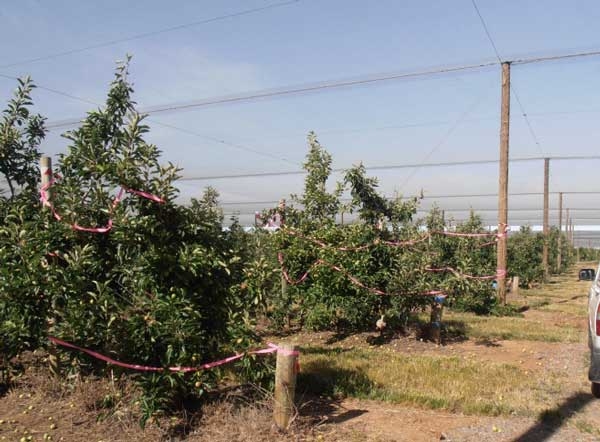part 3:
Fruit protection with spray-on products, shade-netting or evaporative cooling can help reduce sunburn during heatwaves.
In the first two articles in this series we considered the causes of different sunburn types along with orchard design and tree training options to reduce sunburn. This month, additional techniques to reduce fruit temperature and sunburn are examined.
Spray-on sunburn protectants
The effects of spray-on protectants have been largely unreported under SE Australian conditions.
Anecdotal information from our recent heatwaves suggests that these coatings can be of benefit but results have been variable, possibly because rates of application have been inconsistent or environmental factors have degraded coatings at differing rates.
Depending on formulation, the main roles of spray-on protectants are to absorb damaging ultraviolet-B light or reflect incoming solar radiation to reduce fruit temperature.
If they act primarily to lower the impact of ultraviolet-B, fruit temperatures can still rise to damaging levels during extreme summer conditions and fruit may still experience injury such as sunburn necrosis.
A well formulated spray-on protectant should protect fruit while allowing photosynthesis and normal fruit development and colouring to continue with no adverse effects.
Sun blockers
Most sprayable protectants act as sun blockers by creating a white particle-film coating on fruit to reflect or block light.
Calcium carbonate or kaolin clays composed of alumina, silica and water are common constituents. A downside of these products can be a residue on fruit at harvest but normally this is removed during washing processes in packing sheds.
Surround®WP
In one processed formulation, marketed as Surround® WP, kaolin has been found to reduce apple fruit surface temperatures and reduce sunburn.
Overseas, maximum fruit surface temperatures of Scarlet Delicious and Fuji apples were reduced by approximately 3C with Surround WP (Glenn & Puterka 2005).
It significantly reduced the number of Braeburn fruit with visible sunburn damage and fruit temperature was 20% lower (Wünsche et al. 2004).
In the USA, Surround WP helped protect Fuji and Honeycrisp apples from sunburn but when the film was applied later in the season, there was a reduction in red colour and fruit size (Schupp et al. 2002).
Wand et al. (2006) applied the formulation to five apple cultivars in South Africa and found no significant effect on fruit surface temperatures, and sunburn reductions were variable.
Raynox®
Raynox® is a wax-based sunburn protectant that is unique in serving as a sunscreen.
It contains both organic and inorganic constituents, dries as a clear film and absorbs some damaging ultraviolet-B radiation.
In Washington USA, Raynox reduced sunburn browning of apples by about 50% on average; it more effectively prevents sunburn browning than sunburn necrosis (Schrader 2011).
Raynox is not removed by over-tree water cooling or rain, making management easier.
Raynox used in combination with evaporative cooling is considered to be best management practice for reduction of apple sunburn in Washington, USA (Schrader et al. 2008).
Shade-netting
Until recently, the shade provided by over-tree netting that helps to reduce fruit sunburn was usually a secondary benefit arising from the need to protect crops from hail and pests.
However, over the past five years, protection from sunburn damage has become an important new driver in SE Australia for installation of nets.
Effectiveness
Effectiveness of netting for sunburn reduction depends on several factors including: colour, weave density and presence or absence of side walls.
Solomakhin & Blanke (2010) propose that white hail-nets, as compared with red-black or green-black nets, protect against sunburn and by allowing more light penetration, still obtain production of good quality, well coloured fruit.
Weave density is the openness of a fabric—a measure of the ratio of fabric threads to gaps between threads.
Tightly woven, dense netting incorporates fewer holes and blocks more light transmission thereby making it potentially more effective in preventing sunburn.
Wind beneath the netting facilitates transfer of heat from the fruit surface to the air and this reduces sunburn risk.
Side walls can restrict under-net air movement. Growers are advised to seek technical information from their potential suppliers.
Environment
The environment beneath netting is most obviously characterised by lower radiation levels. (continues next issue)
See this article in Tree Fruit January 2015




















